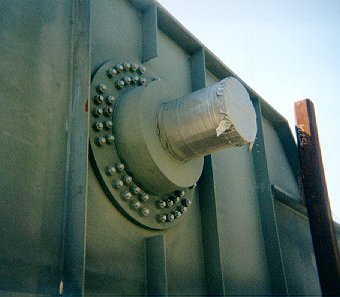|
 To
make the fulcrum, also called trunnion-hub-girder (THG)
assembly, of bascule bridges, a trunnion is shrink fit into
the hub, followed by cooling of the trunnion-hub assembly to
shrink fit it into the girder of the bridge. Development of
cracks on the hub was observed in one THG assembly when the
trunnion-hub assembly was cooled for insertion into the
girder. A suggestion to solve this problem was to study the
effect of radial thickness of the hub and to understand its
influence on critical stresses and crack lengths. American
Association of State Highway and Transportation Officials (AASHTO)
standards call for a hub radial thickness of 0.4 times the
inner diameter, while currently a thickness of 0.1 to 0.2
times the inner diameter is used. In this paper, to
quantitatively find the sensitivity of these parameters on
critical stresses and critical crack lengths, the
geometrical dimensions of the trunnion-hub assembly are
changed following Design of Experiments' standards.
Parameters changed are radial thickness of the hub, inner
radius of the trunnion, and the radial interference at the
trunnion-hub interface. The radial thickness of the hub was
found to be the most influential parameter (90% effect) on
increasing resistance to fracture. To
make the fulcrum, also called trunnion-hub-girder (THG)
assembly, of bascule bridges, a trunnion is shrink fit into
the hub, followed by cooling of the trunnion-hub assembly to
shrink fit it into the girder of the bridge. Development of
cracks on the hub was observed in one THG assembly when the
trunnion-hub assembly was cooled for insertion into the
girder. A suggestion to solve this problem was to study the
effect of radial thickness of the hub and to understand its
influence on critical stresses and crack lengths. American
Association of State Highway and Transportation Officials (AASHTO)
standards call for a hub radial thickness of 0.4 times the
inner diameter, while currently a thickness of 0.1 to 0.2
times the inner diameter is used. In this paper, to
quantitatively find the sensitivity of these parameters on
critical stresses and critical crack lengths, the
geometrical dimensions of the trunnion-hub assembly are
changed following Design of Experiments' standards.
Parameters changed are radial thickness of the hub, inner
radius of the trunnion, and the radial interference at the
trunnion-hub interface. The radial thickness of the hub was
found to be the most influential parameter (90% effect) on
increasing resistance to fracture.
|

a) Trunnion, Hub and Girder |

b) Trunnion fitted into the hub |
|

c) Trunnion-Hub Fit into the Girder |

d) Completed Trunnion Hub Assembly |
Related Papers
C. Nguyen, A.K. Kaw, J. Paul,
"Sensitivity Analysis of Cooling Methods and Geometric
Parameters in Assembly Procedure of Bascule Bridge Fulcrums",
The Journal of Strain Analysis for Engineering Design, pp.
337-349, Vol. 42, 2007.
|

 To
make the fulcrum, also called trunnion-hub-girder (THG)
assembly, of bascule bridges, a trunnion is shrink fit into
the hub, followed by cooling of the trunnion-hub assembly to
shrink fit it into the girder of the bridge. Development of
cracks on the hub was observed in one THG assembly when the
trunnion-hub assembly was cooled for insertion into the
girder. A suggestion to solve this problem was to study the
effect of radial thickness of the hub and to understand its
influence on critical stresses and crack lengths. American
Association of State Highway and Transportation Officials (AASHTO)
standards call for a hub radial thickness of 0.4 times the
inner diameter, while currently a thickness of 0.1 to 0.2
times the inner diameter is used. In this paper, to
quantitatively find the sensitivity of these parameters on
critical stresses and critical crack lengths, the
geometrical dimensions of the trunnion-hub assembly are
changed following Design of Experiments' standards.
Parameters changed are radial thickness of the hub, inner
radius of the trunnion, and the radial interference at the
trunnion-hub interface. The radial thickness of the hub was
found to be the most influential parameter (90% effect) on
increasing resistance to fracture.
To
make the fulcrum, also called trunnion-hub-girder (THG)
assembly, of bascule bridges, a trunnion is shrink fit into
the hub, followed by cooling of the trunnion-hub assembly to
shrink fit it into the girder of the bridge. Development of
cracks on the hub was observed in one THG assembly when the
trunnion-hub assembly was cooled for insertion into the
girder. A suggestion to solve this problem was to study the
effect of radial thickness of the hub and to understand its
influence on critical stresses and crack lengths. American
Association of State Highway and Transportation Officials (AASHTO)
standards call for a hub radial thickness of 0.4 times the
inner diameter, while currently a thickness of 0.1 to 0.2
times the inner diameter is used. In this paper, to
quantitatively find the sensitivity of these parameters on
critical stresses and critical crack lengths, the
geometrical dimensions of the trunnion-hub assembly are
changed following Design of Experiments' standards.
Parameters changed are radial thickness of the hub, inner
radius of the trunnion, and the radial interference at the
trunnion-hub interface. The radial thickness of the hub was
found to be the most influential parameter (90% effect) on
increasing resistance to fracture. 


